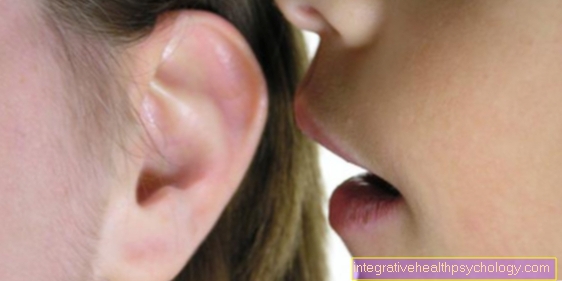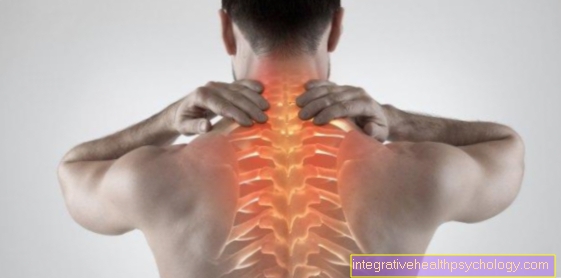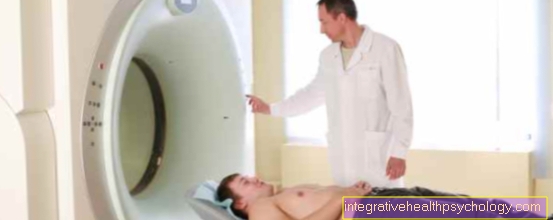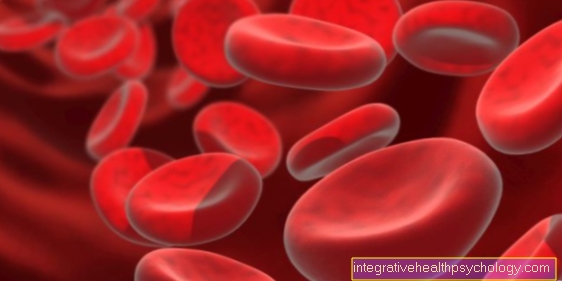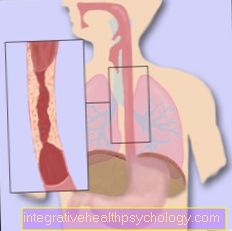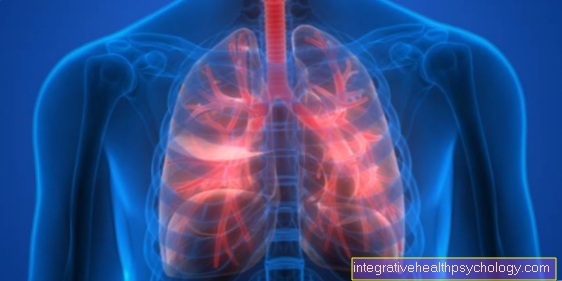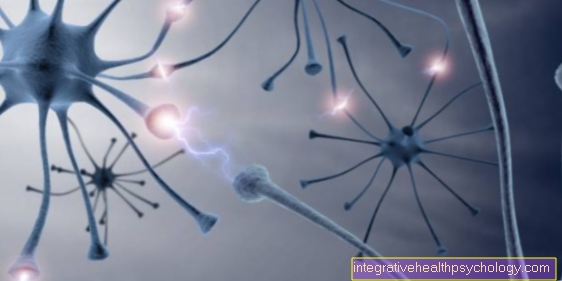Symptoms of pancreatic disease
introduction
The symptoms of pancreatic disease can vary depending on the cause. Characteristically, however, there are belt-shaped upper abdominal pain, impaired digestion of food and, with severe damage to the pancreas, diabetes mellitus.

Pain
Pain emanating from the pancreas is usually described as belt-shaped pain in the upper abdomen or at the level of the navel.
These belt-shaped pains, which also like to radiate into the flanks, are typical, especially with inflammation of the pancreas (Pancreatitis).
Acute pancreatitis almost always results in severe upper abdominal pain, but these often begin with very severe pain in the chest area, so that a heart attack should initially be excluded from the pain picture. The pain then shifts to the upper abdomen over time. With chronic inflammation of the pancreas, the pain is initially mainly in the depths of the upper abdomen. This pain is often recurring and lasts for several days. In the later stages of the disease there is more often a decrease in pain up to complete freedom from pain.
You can read more information on this topic here: Symptoms of inflammation of the pancreas, underactive pancreas
In the early stages of cancer of the pancreas, there is no pain. These only set in at a later stage, when the tumor has grown so large that it narrows the surrounding tissue. The perceived pain then depends on which tissue the tumor is pressing on. This can also manifest itself in the form of back pain.
You can read more information on this topic here: Signs of pancreatic cancer
Back pain
As part of a disease of the pancreas it is not uncommon for back pain to occur, for example in a Inflammation of the pancreas on.
Patients with a acute pancreatitis often complain about sudden severe pain, which are located in the upper abdomen and spread out in a belt-like manner on both sides, often radiating into the back. The back pain is often referred to as increasing, persistent pain described. Inflammation of the pancreas can be accompanied by additional symptoms such as Nausea, vomiting, and fever occur. Acute pancreatitis should be treated by a doctor as soon as possible; an inpatient hospital stay is usually necessary.
Even with one chronic inflammation back pain is not uncommon in the pancreas. As with the acute form, it is often up to Upper abdominal pain radiating to the back. In contrast to the acute form, however, these are usually not that strong, but rather recurring and dull. Here, too, nausea, vomiting and loss of appetite can occur. In the case of advanced, chronic inflammation, the pain can also be completely absent. Another symptom of chronic pancreatitis is often so-called Fatty stoolsbecause the pancreas no longer produces enough enzymes to help digest food.
Another cause of back pain associated with pancreatic disease can be a tumor (Cancer) in the pancreas. One such Pancreatic cancer often develops over a long period of time without any symptoms. Back pain occurs here, for example, when the tumor has already settled in the bones, so-called Bone metastases has formed.
You can read more information on this topic here: Back pain from pancreatic cancer
Flatulence
Flatulence occurs in the context of a pancreatic disease especially when the pancreas no longer produces enough digestive enzymes. These enzymes serve, among other things, the digestion of ingested Dietary fats.
For patients who have a chronic inflammation of the pancreas there is a gradual decrease in pancreatic tissue. If the part of the pancreas is affected, which is responsible for the formation of digestive enzymes (so-called exocrine tissue), the enzyme deficiency mentioned occurs and this results Flatulence, abdominal pain, and fatty stools.
To relieve the symptoms of a deficiency in digestive enzymes, there are medications that provide the needed Replace enzymes. These must daily and lifelong be taken with meals. The flatulence and stool abnormalities are often almost completely reduced.
diarrhea
Since the pancreas produces numerous enzymes that we need to digest our food, disturbances in the production of these enzymes initially lead to flatulence and later to diarrhea (diarrhea) and fatty stools (steatorrhea).
One group of the digestive enzymes formed is used to break down the proteins taken in with food. A second group of enzymes takes care of the breakdown and breakdown of carbohydrates. The so-called pancreas lipase is now responsible for breaking down fats. If, for example, there is a deficiency in the enzymes as part of pancreatic insufficiency, stools that are very fat and voluminous can result.
However, diarrhea and fatty stools are not early symptoms of diseases of the pancreas, but symptoms that only appear at a later point in time. The diarrhea and fatty stools are the result of a massive enzyme deficiency, which leads to considerable disturbances in food digestion and usually only occurs when only about ten percent of the original pancreatic tissue is still available and able to work.
If there are no other symptoms, such as typical pain, fever and / or nausea, that indicate a disease of the pancreas, the probability that the trigger for diarrhea is a disease of the pancreas is to be assessed as relatively low .
also read: Functions of the pancreas
Diabetes mellitus
If the pancreas tissue, which is responsible for the formation of insulin (endocrine tissue) is destroyed, a Insulin deficiency and consequently to one Diabetes mellitus.
The lack of insulin means that too little sugar is transported from the blood into the body cells and the blood sugar level rises. Like diarrhea and fatty stools, diabetes only occurs relatively late, as here too Tissue loss of 80-90% must be available.
Diabetes mellitus is usually pretty severe few symptoms and uncharacteristic with general symptoms, such as Fatigue, exhaustion and decreased performance. In the later process it can become increased urination (Polyuria), increased feeling of thirst (Polydipsia) and possibly to recurring urinary tract infections come because the sugar is excreted in the urine and is a favorite food for bacteria.
You can read more information on this topic here: Diabetes mellitus and Symptoms of diabetes mellitus
How can I recognize a pancreatic disease myself?
There are not a sure signto recognize a disease of the pancreas itself, however, there are more or less clear indications.
To step strong pain on the in the upper abdomen are localized and up radiate in the back and that continue, this can be an indication of a Inflammation of the pancreas be. Dull pain in the upper abdomen and back that recurs again and again can be indicative, usually of a chronic inflammation. A common reason for inflammation is persistent alcohol consumptionHowever, an acute inflammation will most often from gallstones triggered. So if the pain mentioned above occurs and there is either regular alcohol consumption or gallstones are known, then there may be inflammation of the pancreas.
Symptoms exist like a clear one unwanted weight loss, profuse night sweats, fever and recurring pain in the abdomen and back, a doctor should be consulted promptly in any case, as this can be an indication of a malignant disease in the pancreas (pancreatic carcinoma).
Diagnosis and therapy
The diagnosis of pancreatic disease is usually made using the described symptoms, one Blood test and one Imaging in the form of an ultrasound examination or CT / MRI examination.
The therapy for all pancreatic diseases consists of a sufficiently strong pain therapy. You can also Opioids are used for lighter pain is often used Tramadol chosen, while it is also used for stronger pain Pethidine or Buprenorphine comes. Morphine If a pancreatitis is suspected, it is rarely or not administered at all, as a possible side effect of morphine is an occlusion of the pancreatic duct. The morphine derivatives are considered harmless with regard to this side effect.
In case of acute inflammation of the pancreas there is also one adequate hydration very important as a lot of fluid is lost through inflammation. In the case of chronic inflammation, on the other hand, they tend to be Substitution of enzymes and insulin in the foreground.
Causes of Pancreatic Disease
Inflammation of the pancreas
The inflammation of the pancreas is divided between acute and chronic Inflammation of the pancreas (Pancreatitis).
With and the acute Form there is severe, sudden pain in the Upper abdomenthat are also in the Radiate back can. The so-called "rubber belly" is typical for this. The belly has a firm, elastic consistency. Many patients complain of nausea and vomiting, as well as a high accumulation of gas in the intestine. It can also become a brown-greenish Discoloration of the skin on the flanks and around the belly button. These discolorations often indicate a severe course of the disease. A possible yellow discoloration of the skin and the conjunctiva is another symptom of acute pancreatitis. Some patients also complain of an increase in the ascites, i.e. ascites.
The causes of acute inflammation are common Gallstone disease (Cholelitihiasis), as well as a regular one Alcohol consumption. It can also happen that the pancreas becomes inflamed for no apparent reason, then one speaks of one idiopathic Pancreatitis. Rarer causes are inflammation after surgical or diagnostic interventions, such as after an endoscopic retrograde cholangiopancreatography (ERCP), or infections such as with HIV, mumps or one Viral hepatitis.
The chronic Inflammation of the pancreas is mainly caused by it regular alcohol abuse triggered. Chronic inflammation is characterized by severe, belt-shaped Pain off, this pain is recurring and can last for several days. The chronic inflammation can be up to one Loss of function, first the exocrine and later also the endocrine pancreas. The symptoms are mostly a unwanted weight loss and a Yellowing the skin (jaundice).
It can also become a diabetic Metabolic situation come, that means that no longer enough insulin can be produced in order to move the sugar ingested with food from the bloodstream to the body cells. Chronic pancreatitis also promotes the development of Pancreatic cancer (Pancreatic cancer), blood clots in the spleen (splenic vein thrombosis) and a narrowing of the ducts of the pancreas and gallbladder.
You can read more information on this topic here: Inflammation of the pancreas
Cystic fibrosis (cystic fibrosis)
This rare condition will autosomal recessive inherited (i.e. both parents have to pass on the defective gene, even if they are healthy themselves). The cause of these symptoms are Defects in a (chloride) ion channel, which occurs in the most important glands in our body (in the sweat glands, bronchial glands (glands in the pulmonary ducts), in the liver, intestines and in the pancreas, but also in genital organs such as the testes). The result is an increase in the (chloride-containing) table salt content in sweat and the formation of tough, thickened mucus in many glands of the body that are in the lungs too Shortness of breath, to cough and constantly recurrent pneumonia leads. In the pancreas, too, the mucus cannot drain off properly and is surrounded by connective tissue bubbles as an attempt to compensate for the body. In the long run, the entire organ is destroyed and ultimately scarred. The consequences range from Digestive problems (Maldigestion) up to Diabetes mellitus.
Read more on this topic at: Cystic fibrosis
Pancreatic cancer
As in almost every other tissue, malignant neoplasms can also develop in the pancreas. With the so-called Pancreatic cancer (Pancreatic cancer) there are usually more pronounced symptoms in the advanced stage.
Depending on the location of the cancer in the pancreas, back pain or upper abdominal discomfort can occur. A painless one is relatively typical Yellowing the skin and white conjunctiva (jaundice). It can too Indigestion come because the growing tumor also affects the function of the pancreas. As with many other tumors, one will develop unintended weight losswho is also with a Loss of appetite can go hand in hand, and lead to fatigue and decreased performance. Since symptoms usually appear late, curative treatment is not often successful.
You can read more information on this topic here: Symptoms of pancreatic cancer
Summary
Leading symptoms in pancreatic disease are severe upper abdominal painthat can radiate into the flank or even the back. In addition, general symptoms such as Fatigue, nausea, vomiting, and weight loss on.
Typical further symptoms of a disease of the pancreas, which, however, usually do not appear until very recentlylate stages the diseases are occurring Digestive disorders with flatulence, diarrhea and fatty stools, as well as the Development of diabetes mellitus.
Acute inflammation of the pancreas (Pancreatitis) manifest themselves in sudden, severe pain, accompanied by nausea and vomiting. A "rubber belly" and yellowing of the skin usually only appear over time. The symptoms are caused by the release of the aggressive pancreatic enzymes: it comes to Self-digestion of the organ and surrounding structures. The result is an inflammatory reaction that is difficult to control and spreads throughout the body with the risk of one Circulatory shock and other diseases.
Chronic inflammation occurs mainly in alcoholics and is the cause of the indigestion and diabetes caused by the Destruction of the pancreatic tissue arise.
At the Pancreatic cancer it is one of the most vicious Tomor species at all. This type of tumor grows without symptoms for a long time and sets off daughter tumors (Metastases) from. With this combination, the chances of a complete cure for pancreatic cancer are very limited.


